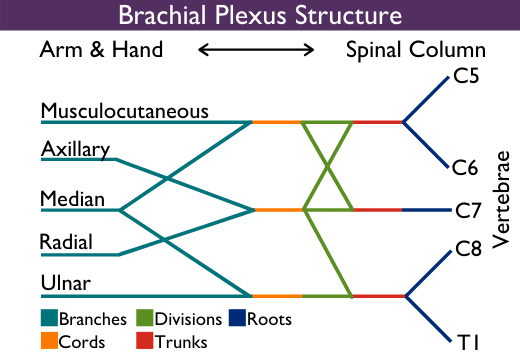The brachial plexus is a network of nerves in the shoulder that carries movement and sensory signals from the spinal cord to the arms and hands. It is a bundle of nerves that stems from the nerve roots in the cervical (neck) and upper trunk (torso) sections of the spinal cord (C5-T1), creating a network that connects to the nerves in the arm. These nerves control the motions of the wrist, arm, and hand. It extends to the skin and are sensory too.

Anatomy
The brachial plexus nerves originate from the spinal cord roots (C5, C6, C7, C8, and T1), and branches and fuse through the shoulder and down the arm. These are classified into a few different sections: trunks, divisions, cords and branches. These sections are not functionally different, but they help explain the complex anatomy of the brachial plexus.

The brachial plexus ends in five major nerve branches that extend down the arm:
- Musculocutaneous nerve: Originates from nerve roots C5-C7 and flexes muscles in the upper arm, at both the shoulder and elbow.
- Axillary nerve: Stems from nerve roots C5 and C6; it helps the shoulder rotate and enables the arm to lift away from the body.
- Median nerve: Starts in nerve roots C6-T1 and enables movement in the forearm and parts of the hand.
- Radial nerve: Begins in nerve roots C5-T1 and controls various muscles in the upper arm, elbow, forearm and hand.
- Ulnar nerve: Rooted in C8-T1, it allows for fine motor control of the fingers.
